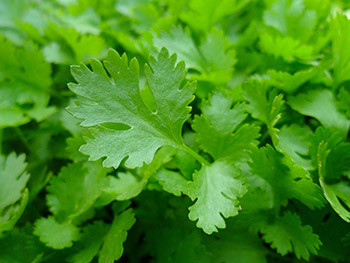
Parsley Description & Health Benefits
- Parsley is part of the Apiaceae botanical family which also includes carrots, celery, and seasonings such as anise, caraway, coriander, cumin, dill, and fennel.
- Parsley comes in two different varieties: flat leaf or curly leaf. The flat leaf parsley tends to have more flavor and is used in dishes more often that the curly leaf parsley which is usually used as a garnish but can also be used in dishes.
- Parsley is a biennial and can easily be grown in a container garden or home garden.
- Parsley is an excellent source of vitamins A, C, and K, and a good source of folate and iron.
- Vitamin A is involved in immune function, vision, and reproduction. It also plays an important role in the formation and maintenance of the heart, lungs, kidneys as well as other organs.
- Vitamin C assists in the absorption of iron, helps to heal wounds, and aids in repairing and maintaining bones, teeth, and cartilage.
- Vitamin K is required for blood clotting and bone building.
- Folate is used to create DNA and other genetic material and reduces the risk of neural tube defects in infants.
- Iron is required for growth and development and is essential to make red blood cells. Red blood cells carry oxygen from the lungs to the rest of the body.
Purchasing, Selecting, Storing, and Preparing
- Purchase parsley with bright green leaves; avoid bunches that are wilted or yellow. Fresh and dried parsley is available year-round at the super market, and fresh parsley can be found at the farmer’s market during the spring/summer.
- Store fresh parsley in a plastic bag in the refrigerator for up to one week. Sprinkle parsley with water if it begins to wilt.
- To prepare, soak parsley in cold water to remove any dirt or rinse thoroughly. Repeat until the rinse water remains clear. Spin the parsley dry in a salad spinner then chop, rip, or cut parsley with a kitchen knife to remove the stems. Leaves are most commonly used, but stems can be used to add flavor to soup stocks.
- When substituting fresh parsley for dried parsley use 1 tablespoon fresh parsley in exchange for 1 teaspoon dried parsley.
Nutrition Facts
½ cup fresh parsley
Calories: 11 | Protein: 0.89 g | Fat: 0.24 g | Carbohydrate: 1.9 g | Fiber: 1.0 g | Calcium: 41 mg | Magnesium: 15 mg | Potassium: 166 mg | Vitamin C: 40 mg | Folate: 46 μg | Vitamin A: 2527 IU
ndb.nal.usda.gov
Request an Appointment

